T-Mobile MyTouch 4G Slide Review - Photographers Wanted
by Vivek Gowri on August 12, 2011 8:45 PM EST- Posted in
- Smartphones
- Snapdragon
- HTC
- 4G
- Mobile
- T-Mobile
- MyTouch
- Slide
Okay, I’ve been mostly ignoring the software side of things here, for not really any good reason, but here it goes. The MT4GS ships with Gingerbread 2.3.4, with a UI skin that basically amounts to a decontented version of Sense 3.0, which Brian covered in depth with his Sensation review. T-Mobile made a whole bunch of changes to the skin, mostly taking features out or just tweaking interface elements.
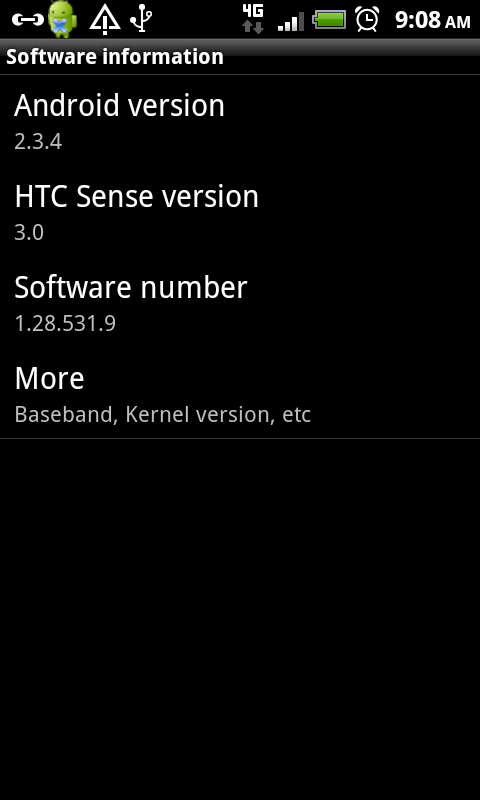
I’m not a huge fan of UI skins. At all. They can make perfectly good phones feel downright slow, and slow phones feel unbearable. For example, the completely unskinned G2 feels subjectively quicker then the Sense-ified MT4GS, even though it’s down a core and has 50% lower clocks. This has nothing to do with how powerful the phone is and everything to do with how responsive it feels in basic OS interactions. Very rarely do they ever add anything of value, especially ones done by LG and Samsung. Surprisingly, I never had as much animosity towards Sense as the others, and certainly not as much as Brian. Sense 3.0 on the Sensation is simply the only UI-skin I’ve dealt with that adds functionality and amounts to a logical reskin of Android.
The skin T-Mobile chose to ship with the Slide is basically Sense 3.0 with all that functionality taken out. The biggest losses here are the lockscreen app shortcuts and the rich info you get from the weather lockscreen. The other disappointing thing is that HTCSense.com features aren’t supported in full as they are on devices with the official version of Sense. This is a pretty big loss, since HTCSense.com comes with some pretty nice features, like remote backups, a locating feature with remote dialing (even when set to silent), remote lock and wipe, editing and multimedia features for photos and video taken on your phone. In my opinion, it’s one of the best things about Sense, but you get none of that with T-Mobile’s custom variant (hereby dubbed nonSense, for lack of a better name).
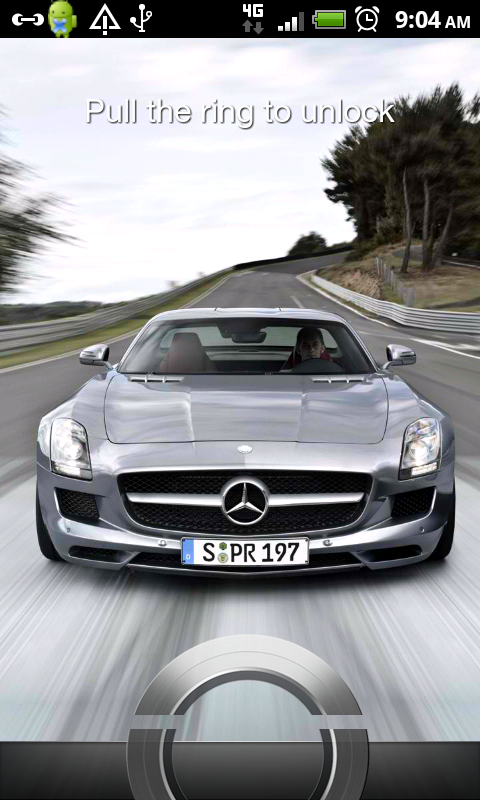
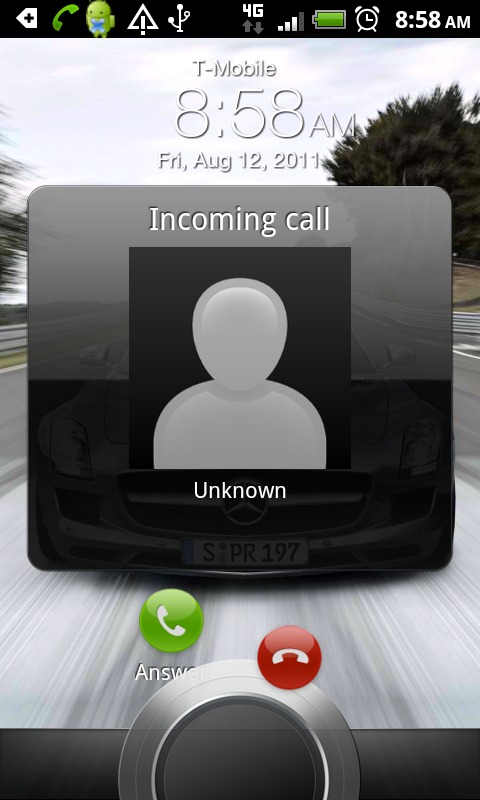
Let’s look at what you do get. The sliding ring is still there, you pull it up to unlock the phone. When you’re answering the phone, you can drag the green and red icons into the ring to accept or decline the call. Alternately, you can swipe the ring upwards to answer the call.

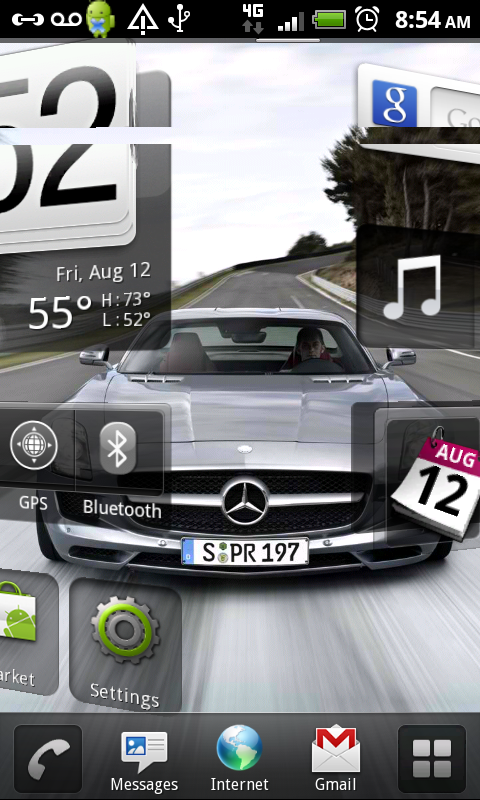
The homescreens rotate in on a circular track, almost like a revolving door of lockscreens. HTC has really emphasized the smoothness of the animations here, but it feels like a waste of computing resources if you ask me. (Sorry for the terrible images, DDMS has some issues with taking screenshots of the rotating motion.) The general interface actions here are identical to those in Sense 3.0. Quickly swiping through homescreens gets the entire deal to spin fluidly, with a virtual version of inertia deciding which screen you land on.
Unlike Sense 3.0, there’s only 5 homescreens and no real easy way to rearrange them. Double-clicking the home button from one of the homescreens gets you an exploded view of all five, but there’s no way to drag them around or anything. Long-pressing on empty space brings up the Personalize menu, which you can also get to by hitting the menu button from the homescreen. You can mess with a bunch of stuff, including the system theme, wallpaper, widgets, folders, app shortcuts, shortcuts to specific parts of certain apps (such as the battery use part of the settings menu, a Gmail label, or a specific playlist in the music app), the ringtone, and notification sound.
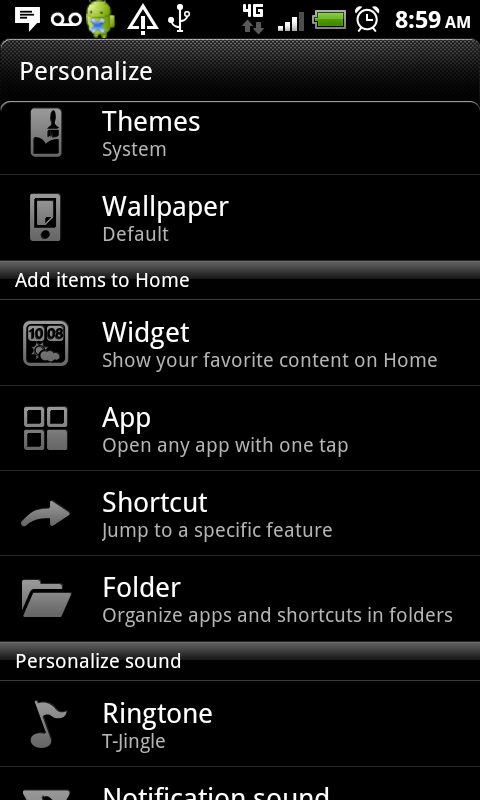
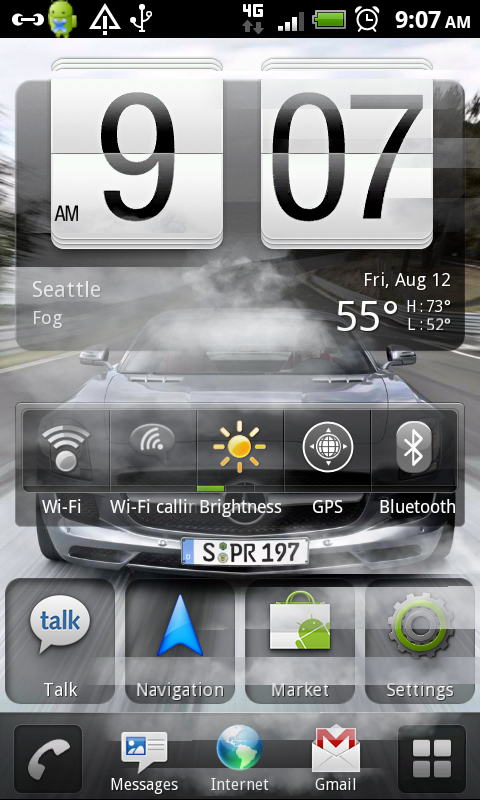
The system theme sounds interesting, but literally all it does is change the wallpaper, ringtone, and appearance of the bottom row of icons. I like having my own wallpapers and ringtones, so it’s only a very small appearance difference to me. The bottom row of icons has its own issues though, in that it has five icons, two of which (phone and app launcher) aren’t modifiable. I like keeping it simple and just having three options - phone, browser, and app launcher. Sense 3.0 messes with it by dumping the browser button for the Personalize menu, but I can live with it. Something about having 4 or 5 icon docks just bugs me, especially when some of the icons are fixed. You get used to it fairly quickly though, so it’s not a huge deal.
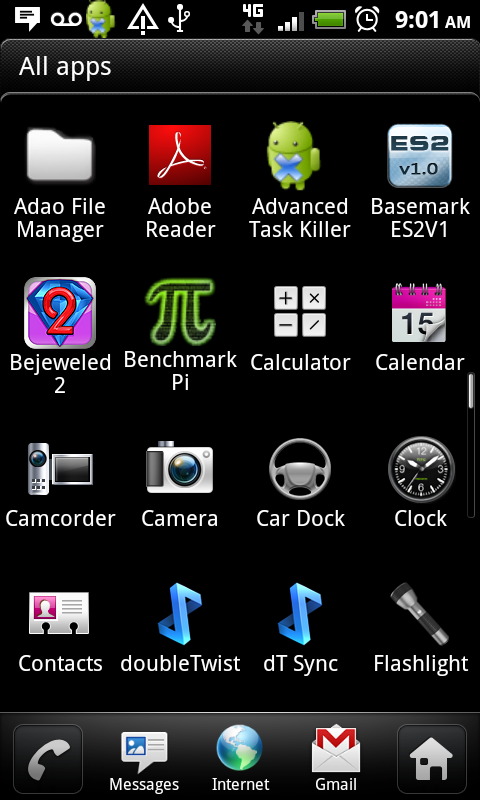
The app launcher is another place where minor annoyances lie. You scroll through pages, grids of 20 at a time, instead of scrolling through by row. This is a feature imported from Sense 3.0, and it’s another one that I personally don’t like. As with the dock, you get used to it. The big difference in the app launcher between Sense 3.0 and the MyTouch-version is that the MyTouch devices lose the tabs, which is actually a bigger loss than I first thought. The frequently-used apps tab is pretty sweet, I’d have liked to see it in this UI.

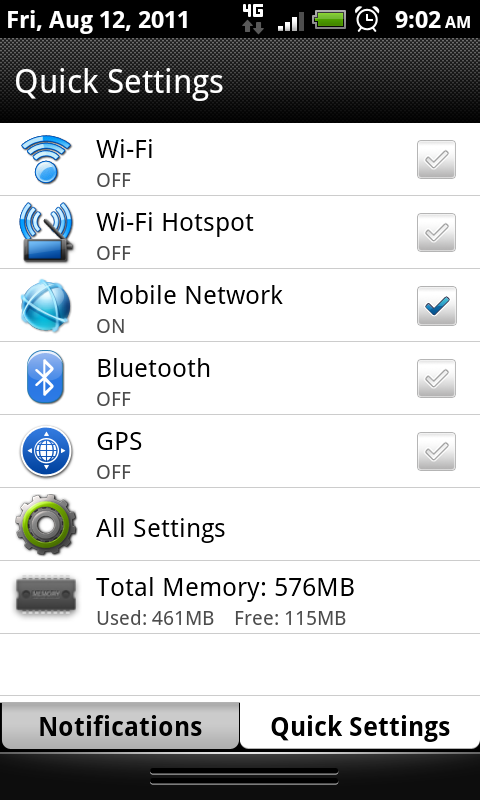
The notifications shade is another carryover piece from Sense 3.0, with a recently used apps list and a quick settings tab. It’s a nice touch, one of the additions I really enjoyed, though a brightness slider would have made it even better. The task manager, too, is a good feature to have built-in, it’s a pretty clean way to manage running applications.
The only other major change is one that I mentioned earlier, with the Search button being replaced by something called the Genius button. Just right off the bat, let me make it known that it’s not as brilliant as T-Mobile seems to think it is. It’s a glorified voice command interface done by Nuance, the company behind Dragon Speech and Ford’s SYNC. It’s a well done bit, but it’s not ingenious. Think of it like Windows Phone 7’s voice command shortcut, and you’ve got the right idea.


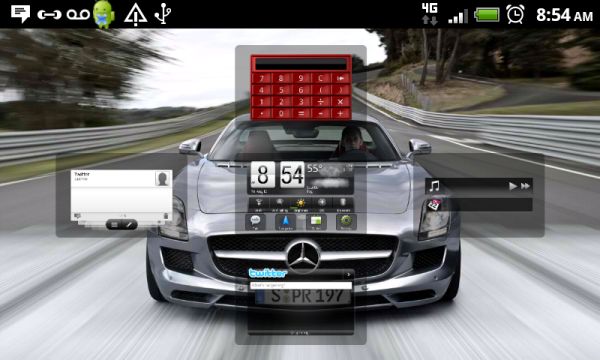









24 Comments
View All Comments
FrederickL - Saturday, August 13, 2011 - link
@Vivek Gowri
Very informative review. With regard to your experience with the 2G I think that the problem may have been that the first shipments of the Desire Z (2G) did indeed have a problem with the construction of that hinge. As far as I can tell (from what I read on various fora at the time) the problem appeared to be largely cured with succeeding shipments. I have had a Desire Z for about half a year now and although the hinge-action has an unusual "feel" to it because of the structural design I have in fact not had any problems with it at all. The disappointment you experienced may be due to the fact that you were an uber early adopter of that phone!
-:)
Frederick
FrederickL - Saturday, August 13, 2011 - link
@Vivek Gown
Another thought just struck me looking at your battery life tests (although I know that this is somewhat off topic). If Nokia manage to produce a WP7 phone with something like the N8's build quality, the camera *and* bring their traditional strengths in call quality and battery life to the table (I am thinking that nobody yet gets seriously near the iPhone's battery life) then they *may* prove the doomsayers wrong. Furthermore if they brought those qualities to one of their classic slider packages I think that even a gentleman like yourself who perhaps feels a touch jaded after seeing so many phones might feel pleased! -:)
VivekGowri - Saturday, August 13, 2011 - link
I definitely agree about the G2 - I went through two in the first week, and they both felt like crap. The later hardware revisions I played with at the T-Mobile store were definitely better, but they still weren't what I would call "confidence-inspiring". I'm comfortable with my decision to sell when I did, but man was that a brilliantly functional phone for it's day.The Nokia WP7 lineup has me so ridiculously excited, you have no idea. I'm an out-and-out Nokia hardware fanboy who has loathed Symbian since the N95 started to get long in the tooth. The first Nokia WP7 device (Sea Ray, the one that looks like the N9) is gonna be bomb, and if they do one like the E7 or the MeeGo slider phone (rumoured to be the N9 back in the day, don't remember the official name off the top of my head), I'll be basically thrilled. I've been using Mango on my HD7 recently, I'm pretty psyched to see it paired with Nokia's brilliant HW design.
dlochinski - Sunday, August 14, 2011 - link
You actually can buy a spring for the g2, (rather cheap and rather strong) and replace the spring inside the g2, then voila, no issues! It is rather unfortunate that it had problems in the beginning, but it is a good phone beyond that.FrederickL - Sunday, August 14, 2011 - link
@Vivek Gowri
Indeed. I currently run my "Z" as my primary and my dear old "Wildfire" as my backup. I will be looking to upgrade my main phone in about a year and as far as I can see my likely choices will be between HTC's then current Android slider and whatever Nokia has presented as its high end WP7 slider. My good lady runs an N8 and as far as the hardware is concerned she loves it but as far as the os is concerned she uses language that would make a Navy Seal blush! I would certainly be looking in about a year (we have an important anniversary coming up) at whatever is then Nokia's flagship cameraphone. All in all the coming year bodes well for choice of good kit in the marketplace. I look forward to it.
Johnmcl7 - Saturday, August 13, 2011 - link
This is the wrong way round:"The lower the F/#, the larger the aperture and the higher the diameter of the lens opening. This gets you a greater depth of field and allows more light to reach the image sensor"
As you widen the aperture the depth of field is reduced, not increased although perhaps that's just the way I read 'greater' to mean deeper depth of field. Either way on such a small focal length the slightly increased aperture isn't really going to have a noticeable effect on depth of field which is going to be very deep anyway.
Thanks for the review although frustratingly while there were rumours of this phone being released in Europe as the HTC Doubleshot (the G2 was released as the Desire Z with Sense intact) I can't see any sign of it on preorder lists so like the Droid 3 it looks like it's not going to be sold here. Which is particularly frustrating given there's no other high end qwerty sliders after the Desire Z.
John
anandtech pirate - Saturday, August 13, 2011 - link
It looks like HTC needs to stop being cheap on the internal storage. 4GB when the standard now is at least 8gb to 16gb.bplewis24 - Saturday, August 13, 2011 - link
Completely agree with the Custom UI rant you threw in there. I hope more reviewers keep harping on it.The Moto D1 had a dedicated camera button that could be long-pressed to open the camera application, so I don't think HTC was copying MS on that one.
Lastly, great review as always. AT is the go-to site for smartphone reviews now. I can't tell you guys how many times I have debunked irrational and subjective criticisms of specific phone/hardware with objective analysis and evidence from these reviews.
VivekGowri - Saturday, August 13, 2011 - link
Yeah, I guess I didn't mean that they were copying Microsoft, but the idea was definitely marketed pretty heavily by the WP7 devices. HTC has put out enough WP7 devices in the last year that taking that feature to Android seems pretty logical.Bristecom - Saturday, August 13, 2011 - link
Good find on the use of two different CMOS sensors. I'd be very interested to see some direct comparison shots and video - particularly in low lighting. I hope you can figure out what sensor the Samsung Galaxy S II uses, although I'm pretty sure it's the S5K3H2.